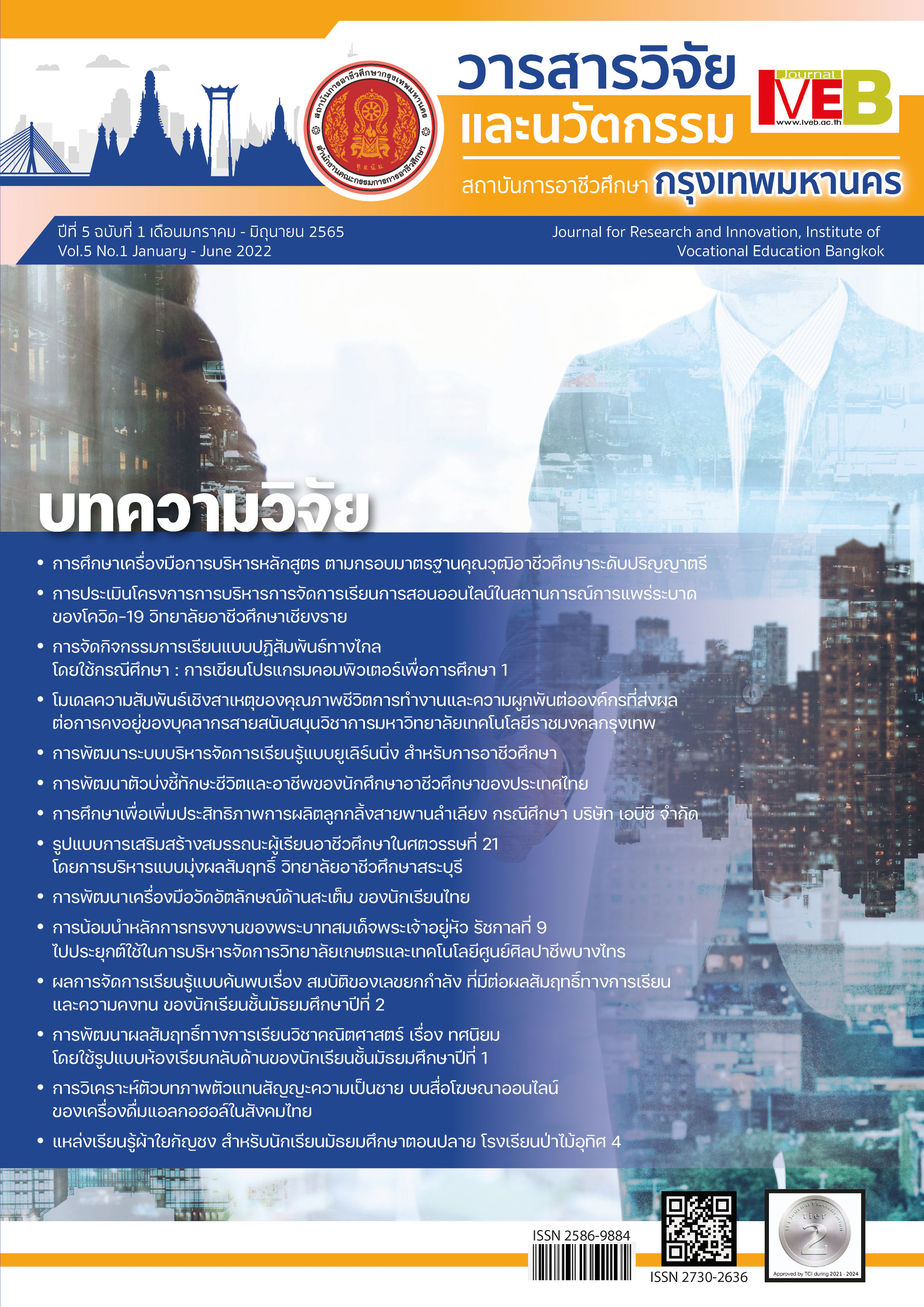The Development Of Mathematics Learning Achievement On Decimal Using Flipped Classroom For Mathayomsuksa 1 The Development of Mathematics Learning Achievement on Decimal Using Flipped Classroom for Mathayomsuksa 1 Students
Main Article Content
Abstract
The objectives of this research were 1) to learning achievement on decimal by using the Flipped Classroom according to the 80/80 criteria 2) to comparison of achievement pre-school and post-learning from teaching and learning achievement on decimal using a Flipped Classroom -based teaching method The effect on the learning achievement of Mathayomsuksa 1 students at Janokrong School 3) to study the satisfaction by using a Flipped Classroom learning management method. decimal of the students Mathayomsuksa 1, Janokrong School.
The sample consisted of 44 Mathayomsuksa 1 students in one classroom of Janokrong School in the first semester of the academic year 2021. The study was cluster sampling. The research was a learning management plan for 8 and an achievement test on the subject of decimal there are twenty items and four options. The satisfaction questionnaire for teaching and learning management on decimal by using a Flipped Classroom. The statistics were mean, standard deviation and t-test Dependent Samples.
The results of the research showed that (1) the learning management plan by the Flipped Classroom learning management method in mathematics subject matter decimal has efficiency E1/E2 which is higher equals 90.25/81.60 and meets the E1/E2 efficiency criterion of 80/80 (2) comparison of learning achievement before and after learning Management of teaching mathematics subject decimal. The method of learning management found that Flipped Classroom. The post-test average score was significantly higher than pre-test at the .05 level. 3) The satisfaction of Mathayomsuksa 1 students at Janokrong School Those who were taught by using the Flipped classroom learning management method on decimal subjects had a high level of satisfaction.
Article Details

This work is licensed under a Creative Commons Attribution-NonCommercial-NoDerivatives 4.0 International License.
References
[2] กระทรวงศึกษาธิการ. (2560). [ออนไลน์]. ตัวชี้วัดและสาระการเรียนรู้แกนกลางกลุ่มสาระการเรียนรู้คณิตศาสตร์(ฉบับปรับปรุง พ.ศ.2560) ตามหลักสูตรแกนกลางการศึกษาขั้นฐาน พุทธศักราช 2551. [สืบค้นเมื่อวันที่ 8 สิงหาคม 2564]. เข้าถึงได้จาก : http://academic.obec.go.th/images/document/1580786328_d_1.pdf
[3] กรมควบคุมโรค. (2564). [ออนไลน์]. แนวปฏิบัติการเฝ้าระวัง ป้องกัน ควบคุมโรคติดเชื้อไวรัสโคโรนา 2019 (COVID-19) ในสถานศึกษา.[สืบค้นเมื่อวันที่ 8 สิงหาคม 2564]. เข้าถึงได้จาก :http://klb.ddc.moph.go.th/dataentry/handbook/form/120
[4] Jureerat Thomthong. (2014). [ออนไลน์]. ห้องเรียนกลับด้าน (The Flipped Classroom). [สืบค้นเมื่อวันที่ 10 สิงหาคม 2564]. เข้าถึงได้จาก: https://prezi.com/o1 meklxbpyl2 / the- flippedclassroom/
[5] ไพฑูรย์ สินลารัตน์. (2556). วิกฤติการศึกษา : ทางออกที่รอการแก้ไข. กรุงเทพฯ: จุฬาลงกรณ์มหาวิทยาลัย.
[6] Bergman G. and Sams S. (2012). Flip Your Classroom Reach Every Student in Every Class Every Day. USA: Colorado Publishing.
[7] พัชฎา บุตรยะถาวร. (2558). ผลการสอนของวิธีการสอนแบบห้องเรียนกลับด้านด้วยการเรียนออนไลน์กับวิธีการสอนแบบสืบเสาะ เรื่อง ระบบไหลเวียนโลหิต. วิทยานิพนธ์ วท.ม.(ชีววิทยาศึกษา). มหาสารคาม: บัณฑิตวิทยาลัย มหาวิทยาลัยมหาสารคาม.
[8] ลัทธพล ด่านสกุล, ผดุงชัย ภู่พัฒน์, ศิริรัตน์เพ็ชร์ แสงศรีและบุญจันทร์ สีสันต์. (2557). ผลของการจัดการเรียนรู้แบบห้องเรียนกลับด้านด้วยพอดคาสต์โดยใช้กลวิธีการกำกับตนเองที่มีผลต่อผลสัมฤทธิ์ทางการเรียนเรื่องโครงสร้างการโปรแกรมและการกำกับตนเองของนักเรียนห้องเรียนพิเศษวิทยาศาสตร์.การประชุมวิชาการระดับชาติ โสตฯ–เทคโนฯ สัมพันธ์แห่งประเทศไทย ครั้งที่ 29. 325-326.
[9] สุภาพร สุดบนิด, สมบัติ ท้ายเรือคำ และบังอร กุมพล. (2556). การเปรียบเทียบ ความรับผิดชอบต่อการเรียน เจตคติต่อการเรียนและผลสัมฤทธิ์ทางการเรียน วิชาวิทยาศาสตร์ของนักเรียนชั้นมัธยมศึกษาปีที่ 1 ที่ได้รับการจัดกิจกรรมการเรียนรู้ตามแนวคิดห้องเรียนกลับทาง (Flipped Classroom) และการจัดกิจกรรมการเรียนรู้แบบปกติ. วารสารคณะศึกษาศาสตร์มหาวิทยาลัยมหาสารคาม. 7 (ฉบับพิเศษ). 165.
[10] ลัลน์ลลิต เอี่ยมอำนวยสุข. (2555). การสร้างสื่อบนอุปกรณ์คอมพิวเตอร์พกพา เรื่องการเคลื่อนไหวในระบบดิจิตอลเบื้องต้น ที่ใช้วิธีการสอนแบบห้องเรียนกลับด้าน. วิทยานิพนธ์ปริญญาครุศาสตร์อุตสาหกรรมมหาบัณฑิต, สาขาวิชาเทคโนโลยีการเรียนรู้และสื่อสารมวลชนคณะครุศาสตร์อุตสาหกรรมและเทคโนโลยี มหาวิทยาลัยเทคโนโลยีพระจอมเกล้าธนบุรี.
[11] นิชาภา บุรีกาญจน์. (2557). ผลการจัดการเรียนรู้วิชาสุขศึกษาโดยใช้แนวคิดแบบห้องเรียนกลับด้านที่มีผลต่อความรับผิดชอบและผลสัมฤทธิ์ทางการเรียนของนักเรียนมัธยมศึกษาตอนต้น. วารสารอิเล็กทรอนิกส์ทางการศึกษา. 9 (2). 768-782.
[12] พิมพ์ประภา พาลพ่าย. (2557). การใช้สื่อสังคมตามแนวคิดห้องเรียนกลับด้าน เรื่อง ภาษาเพื่อการสื่อสาร เพื่อส่งเสริมผลสัมฤทธิ์ทางการเรียนของนักเรียนชั้นประถมศึกษาปีที่ 6. วิทยานิพนธ์ปริญญาศึกษาศาสตร์มหาบัณฑิต, สาขาวิชาเทคโนโลยีและสื่อสารการศึกษาคณะศึกษาศาสตร์ มหาวิทยาลัยเกษตรศาสตร์.

